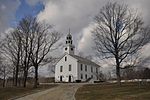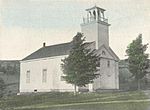Francestown (CDP), New Hampshire
Census-designated places in Hillsborough County, New HampshireCensus-designated places in New HampshireUse mdy dates from July 2023

Francestown is a census-designated place (CDP) and the main village in the town of Francestown, Hillsborough County, New Hampshire, United States. As of the 2020 census, the population of the CDP was 201, out of 1,610 in the entire town.
Excerpt from the Wikipedia article Francestown (CDP), New Hampshire (License: CC BY-SA 3.0, Authors, Images).Francestown (CDP), New Hampshire
New Boston Road,
Geographical coordinates (GPS) Address Website Nearby Places Show on map
Geographical coordinates (GPS)
| Latitude | Longitude |
|---|---|
| N 42.9875 ° | E -71.8125 ° |
Address
Old Meeting House (Francestown Meetinghouse)
New Boston Road 1
03043
New Hampshire, United States
Open on Google Maps










